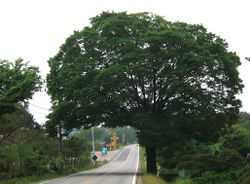
- Domain: Eukaryota
- Kingdom: Plantae
- Subkingdom: Tracheobionta
- Superdivision: Spermatophyta
- Division: Magnoliophyta
- Class: Magnoliopsida
- Subclass: Hamamelididae
- Order: Urticales
- Family: Ulmaceae
- Genus: Zelkova
- Species: Z. serrata [1]
Zelkova serrata
| Japanese zelkova |
|---|
 |
| Scientific Classification |
|
| Binomial Name |
Zelkova serrata |
The Japanese zelkova is a species of tree that is abundant throughout the world, because it is often used commercially, throughout originated in Japan. In wild areas, they can survive in various conditions that most other trees can not.
The Japanese zelkova, known by its genus species name Zelkova serrata, can grow anywhere from 50 to 70 feet. It has steel gray colored bark but as it gets older the bark turns orange. The color of the leaves change by season. During the summer, the leaves stay green because they obtain lots of nutrients. The leaves are 1.25 to 3 inches long and 0.75 to 1.5 inches wide during the summer. They have an acuminate tip which is sharp but the shape of the leaf is very round. During the fall, the leaves have various colors. They are either yellow, russet, bronze, dark red or purple.[2] In Urban cities, the leaves' colors may vary but the majority of the time, the color of the leaf is orange yellow. The round leaf of the tree helps people to recognize it just by looking at it.[3]
The Japanese zelkova has very small fruit, which is approximately 4mm long. The starts with being green but as it ripens, the color of the fruit changes to brown. [4] The fruit is triangular and matures during late summer. The flower is yellow-green and usually appears before the environmental conditions determine the amount of fruits leaves do. [5] The fruit forms in one in a two years. [3]
During the spring time, the color of the tree turns brownish because of the coming of the new leaves and the roots of the flower. After that period all the leaves come out from the root of the stem and turns green. These leaves are their until the fall time. During fall time the color of the leaf changes because it is time for the leaf to die. The color of the leaf is gone because they don't get photosynthesis when its time for those leaves to die out. [3] During the fall season, the flower might get ripen which is very small, not showy. [6]
During the time of winter, there are no leaves showing for this tree. It almost looks like that it is naked for those trees. The color of those trees are almost black, but the tree is already getting ready for spring so one might be able to see the beginning of the flower or a leaf in those periods of time. [3] Sometimes when Japanese zelkovas are close to being dead, the tree itself turns black and it might look like of the tree was burned. [5]
Japanese zelkovas are used in various places. For example they're used as lawn tree, or they're placed in urban areas, parks, and campuses..[2] Japanese zelkovas have originated in Japan but it's well spread in eastern Asian countries. In Asia, which the trees are not intentionally planted, the trees habits in mountains around the water. These trees can grow where rocks are which most trees have hard times settling there. [3] People from various places are finding Japanese zelkova as a replacement for another tree often times. [7]
Even though they naturally grow in Asian areas, people like the look of this tree, and that's why people plant them in urban areas. [3] They can survive very well in urban areas because they are tolerant of heat, drought, wind. During the winter they don't die out because of the temperature because they are tolerant for those conditions. [8] People tend to find this tree because they grow very rapidly during their youth period, and also they are not bothered from air pollution. [9]
Japanese zelkova is spread all around the world, originated from japan, now people can see this tree all over Eastern Asia. People from Eastern Asia easily recognize this tree because in every road blocks they plant this tree due to its beautiful looks and also because the air pollution doesn't effect the tree a lot. [3]
This video shows the tree Japanese Zelkova closely in a close up. The subtitles in the bottom are explaining the origin for the name Japanese zelkova in Korean, why it is that name and how did they name it.
|
||||||||||||||||||||